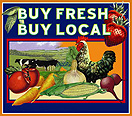Electronic Highways
Fresher, greener, healthier, smarter
What is this article title referring to? It is the answer to the question: “Why eat local?” Being a locavore, or one who tries to eat only foods that are grown or produced locally, is a growing trend across the United States. In 2007, The New Oxford English Dictionary announced that “locavore” was its word of the year.
According to the Agricultural Marketing Service of the U.S. Department of Agriculture, the numbers of farmers markets across the U.S. increased 16 percent between 2009 and 2010, from 5,274 to 6,132. Western New Yorkers have a number of choices when it comes to visiting a market; New York State’s Department of Agriculture and Markets includes a listing of farmers markets in each county. One of the most well attended and vibrant in the Buffalo area is the Elmwood-Bidwell market in the Elmwood Village area of Buffalo. Not only does this market sell products that are grown or produced within the eight counties of Western New York, it often has live musical entertainment; hosts guest chefs, who show market-goers how to prepare different dishes; and on certain weeks Pet Connection, a local adoption group, has animals available for adoption. Most farmers markets open sometime in early May and remain open until early November. An exception of this is the wonderful market in North Tonawanda, which is open year-round. Located at the corners of Payne Avenue and Robinson Street, this market is one of the area’s largest. Be sure to check out the wide variety of products from almost 40 vendors—from fresh locally grown veggies and cut flowers to locally made sausage, cheese and pastries, this market has it all!
An alternative to purchasing locally grown products from a farmers market is to join a CSA, or Community Supported Agriculture program. A CSA is a cooperative business structure in which one can purchase shares per season, which is usually the summer season but can include separate spring or fall seasons. Shares typically consist of a box or bag of seasonal produce; some CSAs have shares delivered to a few locations for pickup, while others may require that you go directly to the farm to receive your produce. While many CSAs are limited to vegetables and/or fruit, others will include such items as homemade bread, jam, flowers or eggs. Some local CSAs you may want to check out are Native Offerings Farm, Porter Farms and Thorpe’s Organic Family Farm.
If starting your own garden doesn’t sound too daunting, you may want to make sure you know what hardiness zone you live in to find out when certain crops should be planted. Local organizations that can help you get started are Urban Roots, a cooperative garden center on Buffalo’s West Side, and Grassroots Gardens of Buffalo, a community gardening project that is dedicated to using and revitalizing vacant land. Check your local garden store for seedlings, mulch, tools and much more. The Vegetable Garden is an excellent website that provides information on how to get started or how to improve your vegetable garden.
Some useful resources in the UB Libraries include “Animal, Vegetable, Miracle: A Year of Food Life” by Barbara Kingsolver, which chronicles a year of her family’s life eating off of the land; “Eat Here: Reclaiming Homegrown Pleasures in a Global Supermarket,” in which Brian Halweil argues that eating locally is a win-win situation for consumers as well as producers; and the numerous articles that can be found in the EBSCO database Academic Search Complete. Conducting a search with the keyword phrase “vegetable gardening” produces a number of articles on such topics as farmers markets, growing vegetables and container gardening, among others.
Eating locally is the right choice. Whether you choose to purchase or grow your own food items, you will be helping to keep not only yourself healthy, but the local economy as well.
—Cindy Ehlers, Arts & Sciences Libraries


Reader Comments